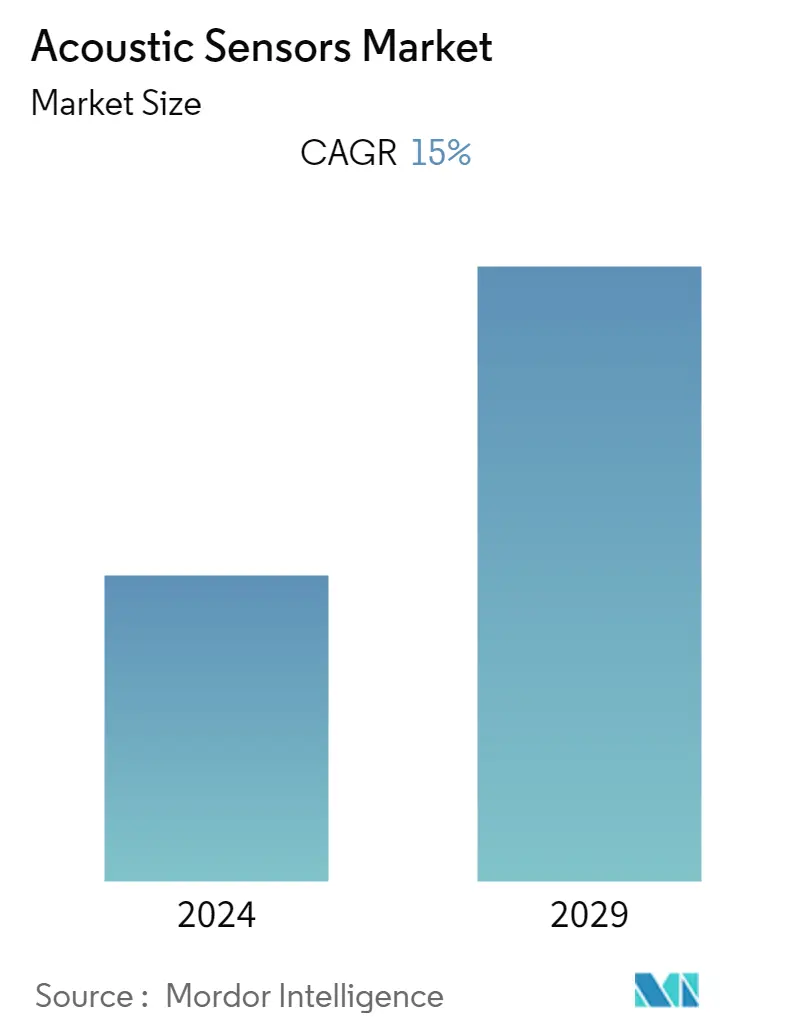Market Size of Acoustic Sensors Industry

| Study Period | 2019 - 2029 |
| Base Year For Estimation | 2023 |
| CAGR | 15.00 % |
| Fastest Growing Market | Asia Pacific |
| Largest Market | North America |
| Market Concentration | Low |
Major Players
*Disclaimer: Major Players sorted in no particular order |
Acoustic Sensors Market Analysis
The Acoustic Sensors Market is expected to grow at a CAGR of 15% during the forecast period. The surface wave acoustic sensor is expected to have high growth during the forecast period due to its implementation in television transmitters and radios to generate signals for broadcasting. SAW devices are indispensable as filters in radio frequency applications and are important components used in the terminals and base stations for satellite communication.
- Over the last few years, surface acoustic wave (SAW) technology was significantly adopted across some industry applications, including aerospace, telecommunication, and automotive. The most common use is in electronic components known as SAW filter, a basic radio frequency (RF) circuits component. SAW devices are utilized to measure humidity, pressure, and temperature and detect certain chemicals.
- Furthermore, acoustic sensors have recently seen significant demand in automotive applications. The complete silence of the motors used in electric cars may pose a hazard to inattentive pedestrians. As a result, the new electric and hybrid vehicles will have to be equipped with an acoustic warning system. Therefore, rising concerns regarding traffic management will drive market growth.
- Further, 5G is likely to create a massive opportunity for the vendors in the market studied to expand their scope, as the world's leading wireless technology innovators push the boundaries of what is possible in mobile technology. With growing filter content in 5G designs, OEM customers are focusing on the attractive combination of higher filter performance, and lower-cost SAW technology. Presently, there are many types of filters, including multilayer ceramic filters, monolithic ceramic filters, acoustic filters, and cavity filters. In smartphone RF front-ends, acoustic filters are mainly used, including SAW filters and BAW filters.
- In the initial phase of COVID-19, the studied market witnessed a disruption in the supply chain owing to a nationwide lockdown and closure of many manufacturing capacities. The healthcare industry expanded the opportunity scope for acoustic sensor technology vendors. Canada-based Research Nova Scotia developed a technology platform to test for the virus using surface acoustic wave (SAW) biosensors. It helped eliminate the need for reagents, sample processing, and specialized personnel. The SAW biosensors can detect very low concentrations and be manufactured from cheap and locally available material. To further contribute to the efforts of the Canadian government and the Province of Nova Scotia to address the COVID-19 outbreak, Research Nova Scotia (RNS) continues to provide rapid response funding from its Research Opportunities Fund. This fund was created by the Province of Nova Scotia to enable RNS to provide financial support to research projects that have the potential to benefit Nova Scotians.
Acoustic Sensors Industry Segmentation
Acoustic wave sensors are a division of micro-electromechanical systems that work on the theory of modulating surface acoustic waves which sense the physical phenomenon. They are used to convert electrical signals into mechanical waves. They are used in various fields, such as signal processing and sensing. The Acoustic Wave Sensors are expected to replace the conventional product in multiple applications due to their passive nature, wireless operation, and lesser response time.
| By Type | |
| Wired | |
| Wireless |
| By Wave Type | |
| Surface Wave | |
| Bulk Wave |
| By Sensing Parameter | |
| Temperature | |
| Pressure | |
| Torque |
| By Application | |
| Automotive | |
| Aerospace & Defense | |
| Consumer Electronics | |
| Healthcare | |
| Industrial | |
| Other Applications |
| Geography | |
| North America | |
| Europe | |
| Asia-Pacific | |
| Latin America | |
| Middle East & Africa |
Acoustic Sensors Market Size Summary
The acoustic sensor market is poised for significant expansion, driven by advancements in surface wave acoustic sensor technology, which is increasingly utilized in telecommunications, aerospace, and automotive sectors. These sensors are integral to radio frequency applications, serving as essential components in satellite communication terminals and base stations. The automotive industry, particularly with the rise of electric and hybrid vehicles, is witnessing a surge in demand for acoustic sensors to enhance pedestrian safety through acoustic warning systems. The advent of 5G technology presents a substantial opportunity for market growth, as the demand for high-performance, cost-effective SAW filters in mobile devices escalates. The consumer electronics sector, especially smartphones and laptops, remains a major consumer of acoustic sensors, with the widespread adoption of these sensors contributing to reduced costs and enhanced device performance.
Regionally, the Asia Pacific is expected to lead the market growth, followed by North America and Europe, due to the increasing application of acoustic sensors in consumer electronics like smartphones and smartwatches. The region's investment in 5G infrastructure is anticipated to further boost the demand for RF semiconductors. The market is characterized by high fragmentation, with numerous global and local manufacturers competing, which has led to price reductions and narrow profit margins. Innovations in MEMS technology and strategic partnerships are key strategies for companies to maintain competitiveness. Recent developments, such as the integration of acoustic sensors in maritime and robotic applications, highlight the ongoing advancements and diverse applications of acoustic sensor technology across various industries.
Acoustic Sensors Market Size - Table of Contents
-
1. MARKET INSIGHTS
-
1.1 Market Overview
-
1.2 Industry Attractiveness - Porter's Five Forces Analysis
-
1.2.1 Bargaining Power of Suppliers
-
1.2.2 Bargaining Power of Buyers
-
1.2.3 Threat of New Entrants
-
1.2.4 Intensity of Competitive Rivalry
-
1.2.5 Threat of Substitute Products
-
-
1.3 Industry Value Chain Analysis
-
1.4 Assessment of COVID-19 Impact on the Market
-
-
2. MARKET SEGMENTATION
-
2.1 By Type
-
2.1.1 Wired
-
2.1.2 Wireless
-
-
2.2 By Wave Type
-
2.2.1 Surface Wave
-
2.2.2 Bulk Wave
-
-
2.3 By Sensing Parameter
-
2.3.1 Temperature
-
2.3.2 Pressure
-
2.3.3 Torque
-
-
2.4 By Application
-
2.4.1 Automotive
-
2.4.2 Aerospace & Defense
-
2.4.3 Consumer Electronics
-
2.4.4 Healthcare
-
2.4.5 Industrial
-
2.4.6 Other Applications
-
-
2.5 Geography
-
2.5.1 North America
-
2.5.2 Europe
-
2.5.3 Asia-Pacific
-
2.5.4 Latin America
-
2.5.5 Middle East & Africa
-
-
Acoustic Sensors Market Size FAQs
What is the current Acoustic Sensors Market size?
The Acoustic Sensors Market is projected to register a CAGR of 15% during the forecast period (2024-2029)
Who are the key players in Acoustic Sensors Market?
Siemens AG, Transense Technologies plc, pro-micron GmbH, Honeywell Sensing and Productivity Solutions and Murata Manufacturing Co., Ltd. are the major companies operating in the Acoustic Sensors Market.

